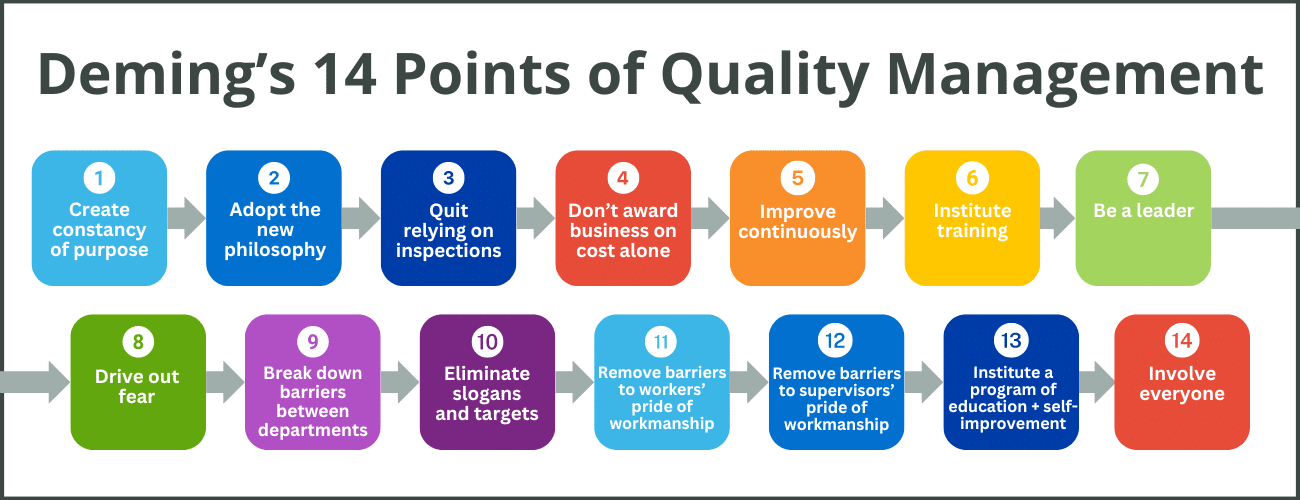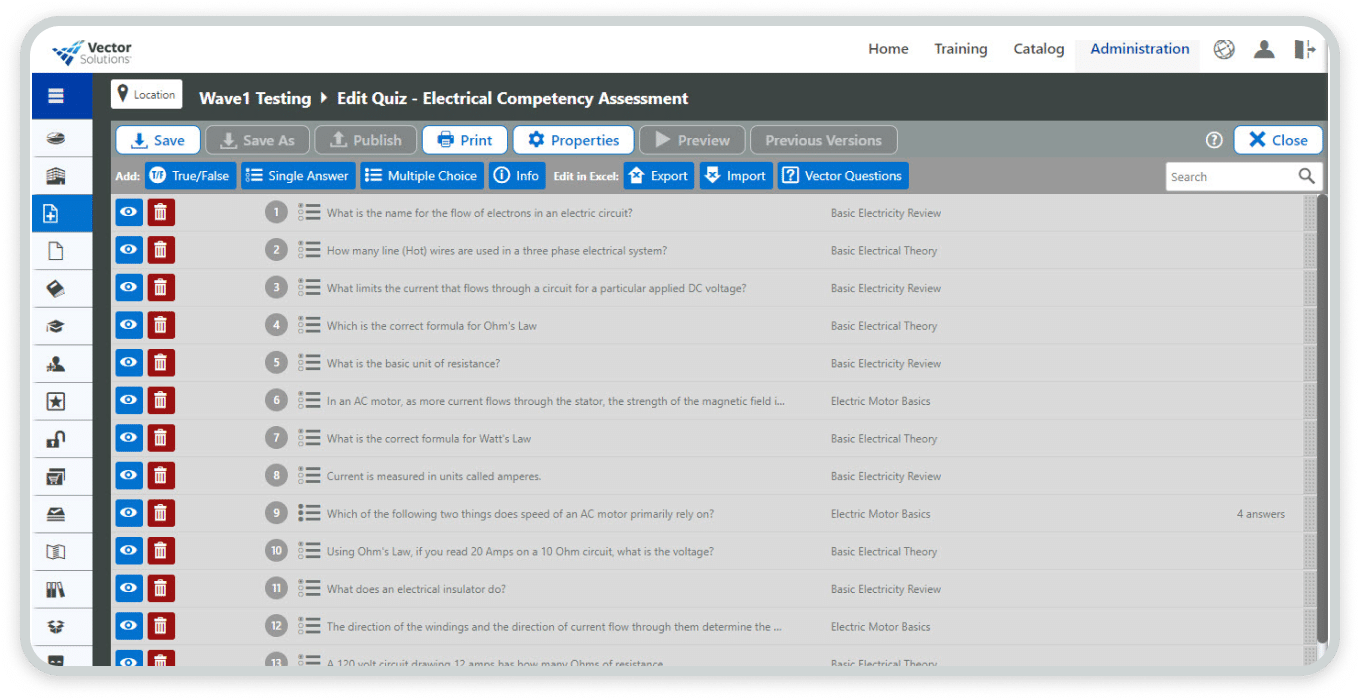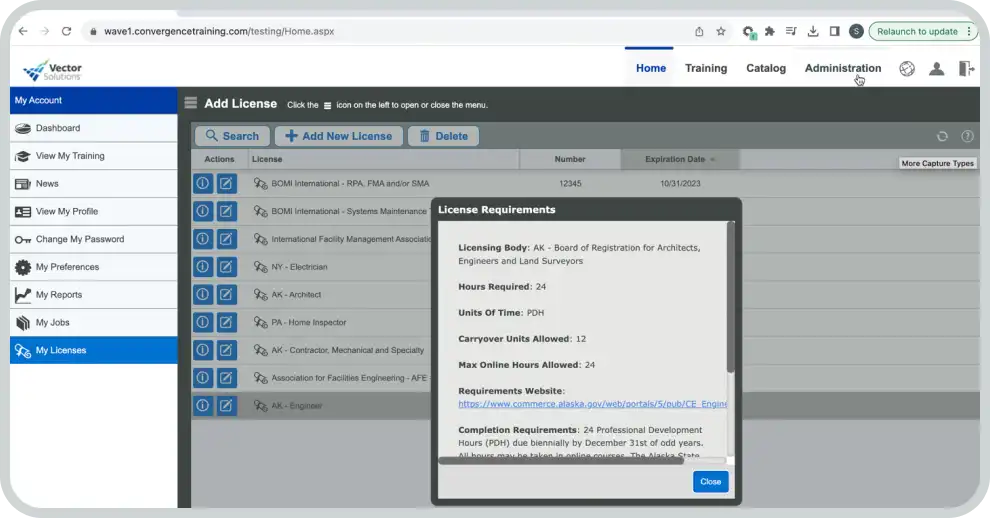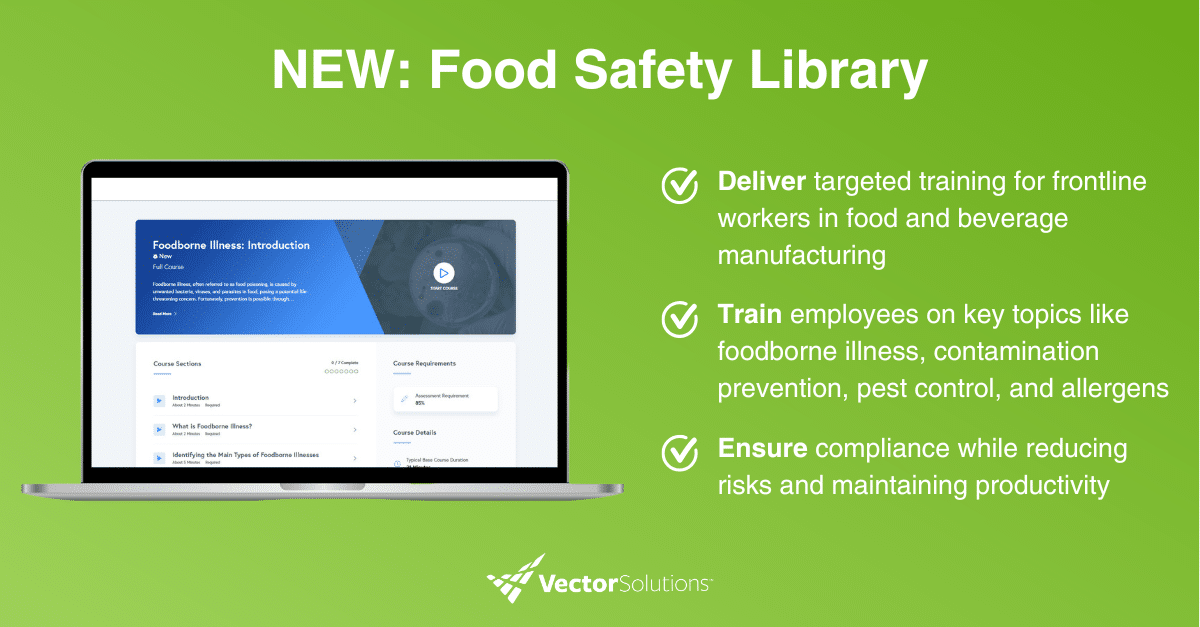August 16, 2024 7 min read

Deming’s 14 Points of Quality Management
Industry:
Solution:

W. Edwards Deming listed 14 points of effective management in his 1982 book Out of the Crisis. These 14 points are considered at the roots of total quality management, although Deming never used that term. In this blog, we’ll break down Deming’s 14 points of quality management and provide tips and resources to implement them in your own organization.
Deming 14 Points Summary
Deming created 14 total quality management principles that, when applied to a business or organization, will improve its effectiveness considerably.
Total quality management, or TQM, is a system of project management stating that every employee must be committed to maintaining high standards of work in each aspect of an organization’s operations.
Deming’s 14 points include:
- Create constancy of purpose
- Adopt the new philosophy
- Quit relying on inspections
- Don’t award business simply on cost
- Improve continuously
- Institute training
- Be a leader
- Drive out fear
- Break down barriers between departments
- Eliminate slogans and targets
- Remove barriers to supervisors’ and engineers’ pride of workmanship
- Remove barriers to supervisors’ and engineers’ pride of workmanship
- Institute a program of education and self-improvement
- Involve everyone in the transformation
In the following section, we’ll explore the meaning behind each of these 14 points.

Deming’s Point 1: Create Constancy of Purpose
The objectives of this step include:
- Continually trying to improve products and services
- Striving to become competitive
- Staying in business
- Providing jobs
By creating constancy of purpose, organizations can ensure quality operations in the future and dedicate themselves to keeping the company alive. Decisions should be made to foster innovation, support research and education, and enhance the product design and service, all while prioritizing the customer.
Deming’s Point 2: Adopt the New Philosophy
This point expresses that:
- Companies must anticipate, recognize, and/or react to the opportunities and challenges that arise from changes.
- Management must be open to change and create an environment that allows change to take place.
With this point, Deming highlights the importance of employees receiving effective training so that they understand their job requirements and feel confident to request assistance when necessary. Supervision must be adequate and effective, and management should be rooted in the company rather than consistently changing positions.
Deming’s Point 3: Quit Relying on Inspections
Organizations should not only rely on inspections and final checks to ensure quality, as these often are reactive rather than proactive. Quality problems arise during the process, so companies must improve the production process at its root.
Deming’s Point 4: Don’t Award Business Simply On Cost
This conveys that organizations should:
- Avoid selecting suppliers simply based on the lowest cost.
- Build a long-term relationship with suppliers based on loyalty and trust, with an emphasis on quality.
- Move toward a single supplier for any one item.
Deming’s Point 5: Improve Continuously
This idea here is that organizations should:
- Constantly attempt to improve their product or service
- Subsequently improve quality and productivity
By striving for continuous improvement, organizations can reduce costs and improve workplace efficiency and productivity overall.
To learn more about fostering an environment of continuous improvement in your organization, check out Vector Solutions’ Continuous Improvement Training courses.
Continuous Improvement Training
With our online quality, reliability, and total productive maintenance training, workforces learn how to "think Lean," detect problems earlier, and continuously improve equipment and processes.
Learn More
Deming’s Point 6: Institute Training
This point emphasizes the importance of providing training to workers as a regular part of their professional development plan.
Organizations may consider using blended learning solutions to combine the benefits of both on the job training (OJT) and online training in their employee training programs.
Deming’s Point 7: Be a Leader
Higher-up employees should be better leaders. Deming emphasizes the importance of helping people, machines, and systems work better together. This allows for a more cohesive and productive workplace environment.
Deming’s Point 8: Drive Out Fear
Organizations should:
- Avoid using fear as a motivating factor at work
- Emphasize psychological safety, trust, open communication, and support
This combination of factors will help employees work more effectively, improving the workplace environment.
Deming’s Point 9: Break Down Barriers Between Departments
By breaking down silos, employees from different departments can communicate, work with, and learn from one another.
A key component of breaking down barriers is acknowledging and respecting one another’s differences. Utilize diversity, equity, and inclusion (DEI) training courses to make your organization a more inclusive, cooperative place for all workers.
Deming’s Point 10: Eliminate Slogans and Targets
Through this point, organizations should:
- Avoid using slogans, catchphrases, or motivational quotes encouraging employees to work harder
- Replace workplace production quotas and management by objective with leadership
Many cases of low quality and low productivity are a result of the systems established in a workplace. By eliminating targets and replacing them with quality leadership, organizations can thrive by reducing employee frustration and cultivating relationships of respect.
Deming’s Point 11: Remove Barriers to Workers’ Pride of Workmanship
Management’s responsibility should be a commitment to quality, not just production. Pride of workmanship should be highly encouraged, while the quota system should be eliminated. Replacing work standards with leadership leads to a significant increase in quality, productivity, and employee satisfaction overall.
Deming’s Point 12: Remove Barriers to Supervisors’ and Engineers’ Pride of Workmanship
Similar to Point 11, companies should get rid of annual or merit rating and management by objectives. In doing so, supervisors’ and engineers’ pride of workmanship can naturally increase, which is highly beneficial to an organization’s productivity and environment.
Deming’s Point 13: Institute a Program of Education and Self-Improvement
Here, Deming communicates that in addition to training, organizations should help create a vigorous program of education and self-improvement for all employees on the job.
To help focus your training program, you need to first understand where your knowledge gaps are. Employee skills assessments are an essential tool for ensuring continued education and improvement within your workforce. Explore best practices for employee skills assessments and utilize competency assessments to ensure your employees are continually receiving the training and education they need to fulfill their respective job roles.
Competency Assessment Tool
Pre-assess knowledge and skills, automatically assign training to close gaps, and verify retention of critical information.
Learn More
Deming’s Point 14: Involve Everyone in the Transformation
Deming’s final point states that organizations should not leave the improvement process solely up to management or a few individuals. Instead, leadership should focus on getting everyone involved to foster a more efficient and cohesive workforce.
Benefits of Deming’s 14 Points
So, why should you consider using Deming’s 14 Points of Quality Management? There are numerous potential benefits:
- Improved quality of products and services
- Increased customer satisfaction
- Enhanced employee engagement and morale
- Reduced employee turnover and improved retention
- Cost reduction from removing inefficiencies, defects, and reducing employee turnover
- Continuous improvement culture
- Better decision making
- Long-term focus
- Greater flexibility and adaptability
How Vector Solutions Helps Companies Embrace Continuous Improvement
“They have a broad range of courses and continue to update the courses, continue to find new twists, new presenters and they’re not hesitant to take criticism if you have a complaint about a course, they listen to you and they work to correct that.”
— Training Manager
Deming’s thirteenth point, to institute a program of education and self-improvement, is very near to our mission to make employees safer, smarter, and better. Without the proper channels to train and upskill employees, you risk losing them to the competition and not capitalizing on the full benefits of quality management.
Here at Vector Solutions, we pride ourselves on offering award-winning training and performance tools for industrial companies to enhance their productivity and efficiency, while simultaneously cultivating the best workplace environment possible.
With our comprehensive Learning Management Systems (LMS), you can explore a wide variety of training courses designed to aid your organization with essential topics such as total quality management and overall workplace improvement.
Learning Management Software For Your Industry
Streamline assigning, tracking, and reporting, online training with this modern learning management system that ensures your workforce stays prepared, compliant, and protected.
Explore Now












